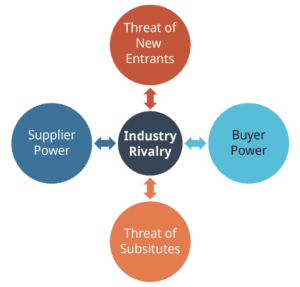What is it?
Porter’s Five Forces Model is a valuable tool created by Harvard Business School professor Michael Porter in 1979. It helps organizations understand the key competitive forces in their industry. Let’s break it down step by step:
Who Created the Five Forces Model?
The Five Forces Model was developed by Michael Porter, a professor at Harvard Business School. He introduced it in 1979 to help businesses gain a better understanding of their competitive environment.
What are the 5 Forces?
Porter’s Five Forces consist of five factors that shape an industry’s competitive landscape.

1. Competitive Rivalry: This looks at your industry’s competition – how many competitors you have, their strengths, and the quality of their products.
2. Supplier Power: Suppliers gain power if they can raise prices easily or reduce product quality. The more suppliers you have to choose from, the better for your business.
3. Buyer Power: Buyer power is strong when there are few buyers relative to suppliers. It means buyers can easily switch to other options, which can drive down prices.
4. Threat of Substitution: This assesses the likelihood of customers finding alternatives to your product or service. It becomes a threat when it’s easy for customers to switch to something better or cheaper.
5. Threat of New Entry: This considers how easy it is for new competitors to enter your market. High barriers to entry can protect your business from new rivals.
How do I use the model?
To use this model effectively, consider each of the five forces in your industry:
– Analyze the strength and impact of each force.
– Identify whether each force is in your favor (+), against you (-), or neutral (o).
– Use this analysis to make informed strategic decisions, and find ways to improve your competitive position.
Example
Let’s say you’re a business owner thinking of entering the agriculture industry. By applying Porter’s Five Forces, you can uncover potential challenges like high threats of new entry, intense competitive rivalry, strong buyer power, and threats of substitution. This information can guide your decision-making process and help you find ways to succeed in a tough market.
FAQs
– Purpose: It helps analyze industry attractiveness, evaluate investments, and assess the competitive landscape.
– How to Use: Analyze each force, gather data, and use the results for strategic decision-making.
– Benefits: Provides insights into your market, aiding strategy development.
– Difference from SWOT Analysis: While SWOT focuses on internal factors, Porter’s Five Forces examine external competitive pressures.
– Macro or Micro Framework: It’s a micro-environment tool, focusing on immediate industry forces.
– Relevance Today: Some argue it may not fully address modern market dynamics but Porter contends it’s still valuable for understanding industry structure.